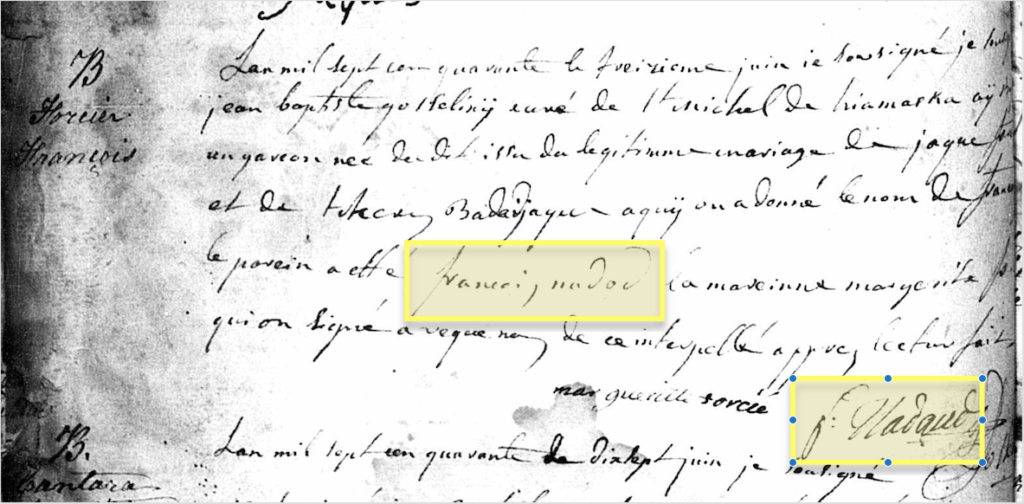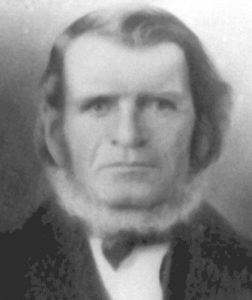Anyone doing French-Canadian genealogy eventually runs across “dit” (pronounced “dee”) names. Meaning “called,” the “dit” name functioned like an alias or a second surname. It could be used together with the regular surname or as a substitute. Sometimes the “dit” name was not necessary and was left out of certain records. Not all French-Canadian individuals or families had a “dit” name. So where did “dit” names come from? How were they chosen? A cousin of mine recently asked me me about the origin of a specific “dit” name, that of Francois Forcier dit Nadeau (1740-1800). I thought I would share my findings with all of you, since they help answer the broader questions posed above.

In general, “dit” names became common in French Canada as a way to help distinguish different branches of the same family. The founding population of French Canada numbered only about 20,000 settled immigrants during the French period, and due to the colony’s early gender imbalance, only about half of those individuals left behind descendants. All of our French-Canadian heritage thus goes back to the same 10,000 or so founders. That may sound like a lot, but it’s actually not that many families, only a few thousand. As the years progressed, the population expanded rapidly from this small founding stock. A few of the original settlers already had 5,000 to 10,000 married descendants by the year 1800! As you can imagine, some families had dozens of people alive at the same time who shared the same handful of common given names: Joseph, Francois, Jacques, Pierre, Louis, Jean, and Jean-Baptiste; Marie, Marguerite, Magdaleine, Louise, Josephte, and Francoise. This was the case with the Forcier family.
The Forcier family in Quebec goes back to a single couple, Pierre Forcier and Marguerite Girard, who married in about 1670. Pierre and Marguerite settled on a farm in the parish of St-Francois du Lac, a few miles inland from the south shore of the St. Lawrence River between Montreal and Trois-Rivieres. Pierre and Marguerite had four surviving children, including two sons, Joseph-Antoine and Jacques. These two men each fathered four sons of their own who left descendants. As the family grew through several generations, many younger Forciers moved into the neighboring parish of Yamaska. Within three or four generations, by the 1730s and 1740s, the Forcier families of St-Francois du Lac and Yamaska faced the dilemma of how to keep everyone straight without each person needing to recount his or her full lineage. “Dit” names were one solution.
How did a person choose a new “dit” name? In our case, why Nadeau? Historically, “dit” names had many sources. Some were nicknames given to soldiers. Some were descriptive. Jean Lehay dit Hibernois, for example, was an Irishman taken captive in upstate New York during King William’s War. After marrying and settling down in New France, he was given the “dit” name Hibernois, “the Irishman,” a name many of his descendants continued to carry. Sometimes the “dit” name derived from the mother’s family. One branch of the Petit family carried the “dit” name Gobin. The founding couple of this line was Francois Petit and Jeanne Gobin.
Francois Forcier dit Nadeau appears to have chosen (or been given) the “dit” name Nadeau in honor of Olivier-Francois Nadeau, his godfather and uncle-through-marriage. Francois Forcier was born and baptized June 13, 1740, and Francois Nadeau was listed as his godfather. Marguerite Forcier, Francois Forcier’s aunt, was his female sponsor. Two years later, on April 3, 1742, Olivier-Francois Nadeau married Marguerite Forcier.

Source: “Québec, registres paroissiaux catholiques, 1621-1979,” database with images, FamilySearch (https://familysearch.org/ark:/61903/3:1:3QS7-L993-Z98D?cc=1321742&wc=9RLD-DPG%3A21947601%2C21947602%2C21947603 : 16 July 2014), Saint-Michel-d’Yamaska > Saint-Michel-d’Yamaska > Baptêmes, mariages, sépultures 1727-1775 > image 71 of 368; nos paroisses de Église Catholique, Quebec (Catholic Church parishes, Quebec).
The Forciers ended up with three distinct “dit” names: Nadeau, Gaucher, and Mette. (I haven’t researched the origins of the other two “dit” names, but gaucher means left-handed.) Most of Francois’s descendants continued to use the “dit” name Nadeau (though it’s not included on every record). The three “dit” names helped keep different branches straight. Unfortunately, as the families grew even more, even these three extra names could not provide enough variety to sort out all the problems of identity within the Forcier families of Yamaska. Take, for example, this excellent research case in which the author tried to identify which Pierre Forcier from Yamaska was the one who ended up working for the American Fur Company in La Pointe, Wisconsin, in the 1830s.
“Dit” names in the USA

When French-Canadians emigrated to the United States, they typically stopped using a “dit” name. They almost always reverted to using just a single surname. Be aware, though, your French-Canadian immigrant ancestors might have chosen either their traditional surname or their “dit” name as their permanent surname in the United States.
Francois Forcier dit Nadeau’s grandson Jean-Baptiste Forcier dit Nadeau (pictured at right) chose to drop Nadeau in the United States. He became simply Jean Baptiste Forcier. But Olivier Pichet dit Dupre and his brothers all chose to keep the “dit” name Dupre instead of Pichet. Likewise, Joseph Petit dit Gobin became Joseph Gobin.
If you’re struggling to find the connection between your ancestor in the United States and his or her family of origin in Quebec, plug the surname you know into this search bar to find associated “dit” names. You can also review a list of name variations and “dit” names here. This might be the breakthrough you need.

Great background as I am a Forcier born 1950 still alive
Trying to locate my roots as my dad Ernest George Forcier use to take us to Montreal and Quebec